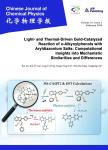Effect of Reagent Rotational Excitation on Dynamics of F+H2→HF+H
试剂转动激发对F + H2HF + H的动态影响作者机构:Key Laboratory of Materials Modification by LaserElectron and Ion Beams (Ministry of Education)School of Physics and Optoelectronic Technology Dalian University of Technology Dalian 116024ChinaState Key Laboratory of Molecular Reaction Dynamics Dalian Institute of Chemical Physics Chinese Academy of Science Dalian 116023 China State Key Laboratory of Molecular Reaction DynamicsDalian Institute of Chemical Physics Chinese Academy of Science Dalian 116023 China State Key Laboratory of Molecular Reaction DynamicsDalian Institute of Chemical Physics Chinese Academy of Science Dalian 116023 ChinaSynergetic Innovation Center of Quantum Information and Quantum Physics University of Science and Technology of China Hefei 230026 ChinaDepartment of Chemical Physics University of Science and Technology of China Hefei 230026China State Key Laboratory of Molecular Reaction DynamicsDalian Institute of Chemical Physics Chinese Academy of Science Dalian 116023 ChinaSynergetic Innovation Center of Quantum Information and Quantum Physics University of Science and Technology of China Hefei 230026 China
出 版 物:《Chinese Journal of Chemical Physics》 (化学物理学报(英文))
年 卷 期:2015年第28卷第4期
页 面:-页
核心收录:
学科分类:07[理学] 0703[理学-化学] 0702[理学-物理学]
基 金:the Chinese Academy of Sciences the National Natural Science Foundation of China the Ministry of Science and Technology
主 题:Crossed molecular beam Rydberg tagging Differential cross sections
摘 要:The dynamics of the F+H2(v=0, j=0, 1) reactions have been studied at the collision energy of 1.27 kcal/mol using a high-resolution crossed molecular beam apparatus. HF product rotational state resolved differential cross sections have been obtained at the v′=1, 2, 3 levels. The product HF(v′=2) angular distributions are predominantly backward scattered for both H2 (j=0, 1) reagents. However, the distributions of product HF(v′=2) rotational states for the F+H2(v=0, j=0) reaction are significantly different from those for the F+H2(v=0, j=1) reaction. Experimental results show that the rotational excitation of H2 produces rotationally hotter HF(v′=2) product. In addition, the HF(v′=3) product is more likely scattered into the forward direction when the H2reagent is populated at j=0 state, which could be attributed to a slow-down mechanism.



